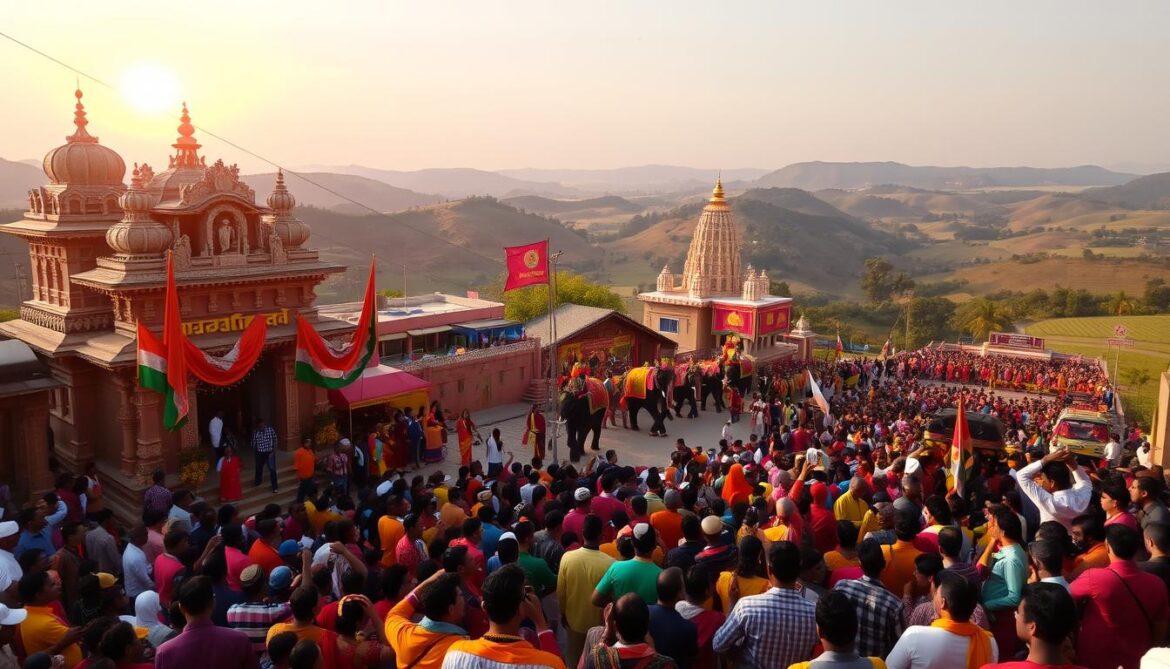In the rich tapestry of Hindu festivals, one celebration stands out for its profound message. This important day marks the victory of good over evil. It occurs on the tenth day of the waxing moon in the month of Asvina.
This festival commemorates a pivotal moment from ancient texts. It honors the time when Lord Rama achieved a great victory. He defeated the ten-headed demon king Ravana, restoring righteousness to the world.
For people across the globe, this is a time of joy and reflection. The event is not just a historical remembrance. It is a powerful symbol of the inner battle against negative qualities.
The celebration brings communities together. They participate in rituals and watch the burning of large effigies. This act symbolizes the destruction of evil forces. The lessons from this day teach people about courage, devotion, and moral integrity.
Historical Origins of Ramacandra Vijayotsava
The historical roots of this important festival stretch back to one of Hinduism’s most revered scriptures. Sage Valmiki’s Ramayana, written thousands of years ago, chronicles the epic story that forms the foundation of these celebrations.
This ancient text details how lord ram accepted fourteen years of exile to honor his father’s vow. During this time in the forest, he faced many challenges that led to his legendary confrontation.
Legend of Lord Ram’s Triumph Over Ravana
The narrative builds toward the climactic battle between lord ram and Ravana, the powerful king of Lanka. Ancient texts reveal deeper mythological connections behind this conflict.
Ravana and his brother were actually divine beings cursed to take three lives as enemies of the Lord. The detailed descriptions of chariot warfare in these accounts provide insights into ancient military customs.
Ancient Rituals and Traditional Narratives
Traditional practices associated with this festival have been preserved across generations. The place of this epic in Hindu consciousness continues to inspire people worldwide.
These rituals maintain their essential character while adapting to different cultures. The story of lord ram‘s victory represents the eternal struggle between good and evil that resonates through time.
The Epic Battle Between Lord Ram and Ravana
When Ravana’s soldiers fell, the demon king himself entered the fray. This set the stage for an extraordinary duel on the battlefield of Lanka. The war reached its climactic moment as these two powerful forces prepared to clash.
The Fierce Duel and Divine Weapons
Lord Ram fought from a celestial chariot driven by Matali. This divine vehicle matched Ravana’s aerial capabilities. The combatants displayed incredible martial prowess throughout the intense confrontation.
In a remarkable sequence, Lord Ram severed Ravana’s head with an arrow. As one head fell to the ground, another one immediately grew in its place. This regeneration continued until one hundred ravan heads lay scattered across the battlefield.
Symbolism Behind Repeated Head Severing
This supernatural phenomenon represents more than literal combat. It symbolizes the persistent nature of evil that regenerates unless struck at its root. Despite appearing in human form as an ordinary human, Lord Ram possessed divine power that would ultimately prevail.
The battle demonstrated that ego and negative qualities can continuously resurface. True victory requires striking at the fundamental source of these destructive forces. This profound symbolism gives the epic confrontation enduring spiritual significance.
Cultural Importance in Traditional Indian Festivities
Indian cultural traditions find their fullest expression during this festive time. The celebration brings together people from all walks of life, transcending regional and social differences. Communities unite in a shared experience that reinforces cultural bonds.
The festival manifests in various forms that engage entire communities. Elaborate Rama-Lila performances recreate epic scenes on temporary stages. These dramatic presentations make ancient stories accessible to modern audiences.
During this time, towns transform with colorful decorations and lights. The ceremonial burning of effigies represents a unique way of preserving cultural narratives. This dramatic spectacle especially captivates children who watch the fire consume towering figures.
Different regions celebrate in their own distinctive way, yet all honor the same principles. The festival serves as an important marker in the annual calendar. It influences social planning and commerce throughout the year.
The cultural significance extends beyond religious observance. Traditional values are reinforced through community participation. This celebration teaches moral lessons in an entertaining form that resonates across generations.
Religious Connections and Spiritual Insights
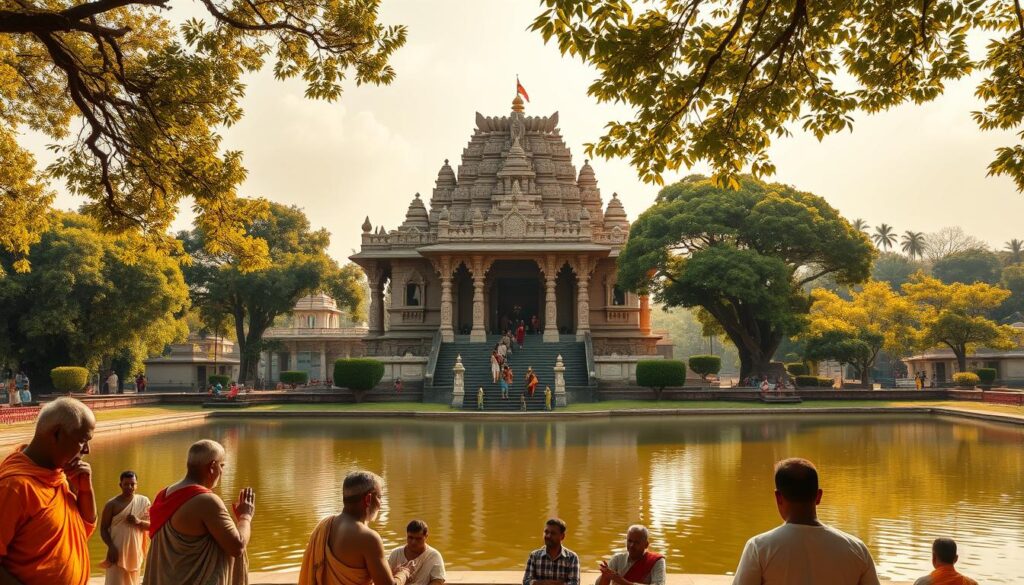
The spiritual dimensions of this ancient story reveal profound truths about cosmic order. This narrative extends beyond mere historical remembrance to embody deeper religious significance.
The Role of Divine Intervention in the Epic
Lord Ram‘s appearance on earth fulfilled a specific cosmic purpose. As Sri Krishna explains in sacred texts, divine incarnations occur to protect righteousness and destroy wickedness.
The story demonstrates how supreme power manifests in human form to accomplish extraordinary tasks. This shows the personal interest divinity takes in maintaining cosmic balance.
Understanding the curse of Jaya and Vijaya provides crucial context. These gatekeepers of Vaikuntha became powerful demons destined to confront the Lord across three eras.
Even during intense war, a higher spiritual logic operates. The chariot battle symbolizes the eternal struggle between spiritual and material consciousness.
One key insight reveals that divine manifestations adapt to each age’s needs. The Lord appears in various forms while maintaining the essential purpose of restoring dharma.
Modern Day Observances and Ritual Practices
Today’s observances transform the epic victory into vibrant community events that captivate millions. The festival occurs on the tenth day of the waxing moon in Ashwin month. Modern celebrations maintain strong connections to ancient traditions while incorporating contemporary elements.
Public Processions and Effigy Burning
The most dramatic moment comes when actors portraying divine figures recreate the legendary victory. A central figure shoots a flaming arrow toward massive effigies filled with fireworks. This creates a spectacular fire display that symbolizes evil’s destruction.
Community volunteers now fulfill roles once held by ancient warriors. They construct elaborate effigies that sometimes tower over 100 feet high. The burning ceremony draws thousands of people to open grounds at the appointed time.
Regional Variations Across India and Beyond
Northern India features prominent Rama-Lila performances spanning several days. Entire communities participate as actors, musicians, and audience members. Each region celebrates in its own distinctive way while honoring the same principles.
The festival has spread globally through diaspora communities. They adapt traditions to local contexts while preserving essential character. Modern technology enhances ancient rituals with sound systems and lighting effects.
Decorated chariot processions wind through streets, recreating epic battles in contemporary way. The name Dussehra appears prominently during celebrations, educating new generations about its meaning. This special time continues to inspire people worldwide through powerful symbolism and community spirit.
The Enduring Legacy of the Ramayana
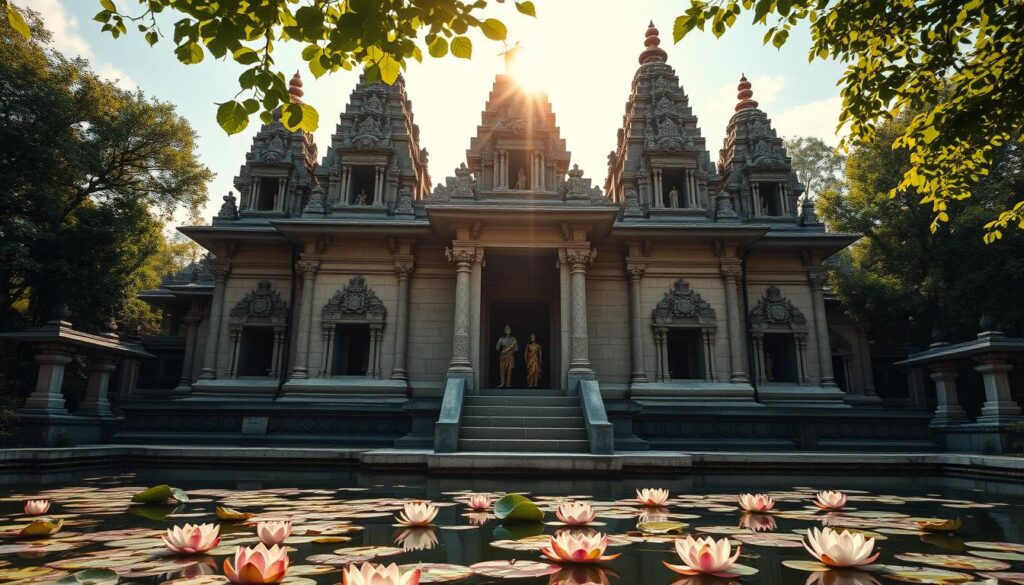
The timeless lessons embedded in Lord Ram‘s exile and eventual victory transcend religious boundaries. This ancient story continues to influence literature, art, and social ethics across Asia and beyond.
Moral Lessons from the Epic
Lord Ram accepted fourteen years of exile to honor his father’s vow. This demonstrates the importance of keeping commitments. His wife Sita and younger brother Lakshman chose to join him in the forest.
Their actions show deep devotion and loyalty. The abduction of Sita from Panchavati near Nashik sets the central conflict in motion. It teaches that evil actions lead to consequences.
When Lord Ram reached the sea with his ape allies, the ocean didn’t part for three days. His frustration shows that even divine beings in human form experience human emotions. The ocean then appeared as an ordinary human with pleading hands.
The construction of Ram Setu across the sea shows how obstacles can be overcome. Sri Krishna later referenced these events when explaining divine incarnations. The moral lessons about duty and honor remain relevant today.
Lord Ram‘s conduct established him as the ideal king. The chariot battles demonstrated honorable warfare. These teachings continue to guide people in their daily lives.
Integration of Traditional Puja and Celebratory Rites
At the heart of the festivities lies a beautiful integration of solemn devotion and joyful community gatherings. This unique blend creates a spiritual experience that balances reverence with celebration. The combination makes the observance deeply meaningful for participants.
Elaborate puja ceremonies occur in temples and homes throughout the festival. Devotees approach with folded hands in the traditional gesture of respect. This humble posture demonstrates recognition of the divine presence they honor.
The vow of Lord Rama promises blessings to any person who approaches with sincere devotion. Community service becomes an important offering during this time. Many organize food distribution and charitable activities as part of their worship.
Traditional puja includes recitation of sacred texts from the Ramayana. Families gather for collective worship, passing knowledge to younger generations. The ceremonies feature worship of divine weapons symbolizing righteousness.
The puja culminates at the exact moment of victory. Priests perform special lamp offerings with raised hands. Bells ring and devotional singing fills the air as celebrations reach their peak.
The Role of Effigies in Vijayotsava Displays
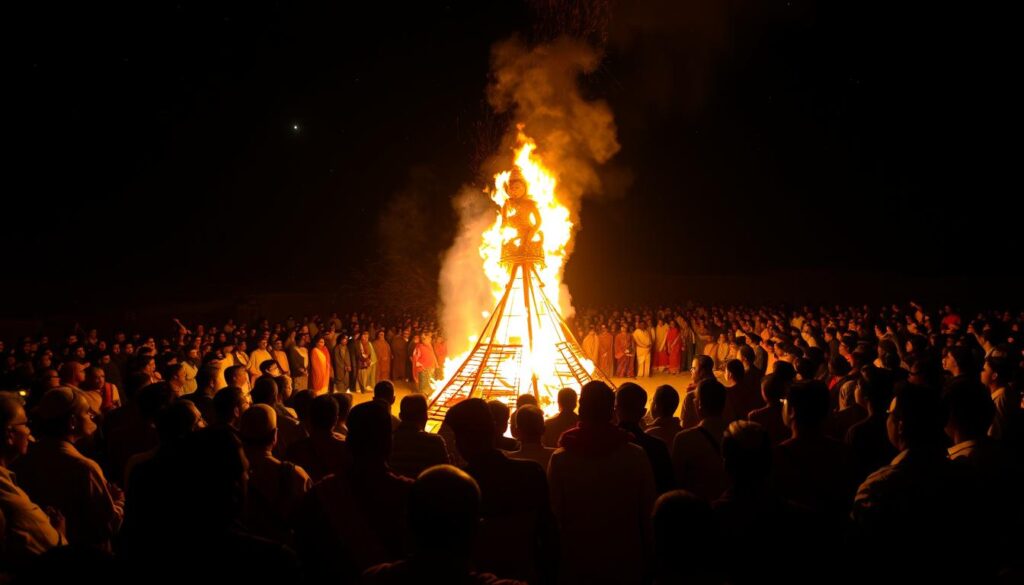
As dusk falls on the tenth day, communities gather to witness a spectacular ritual of fire and symbolism. These towering structures serve as tangible representations of evil that communities can symbolically destroy together.
Artistic Interpretations of Ravana’s Effigy
Skilled craftsmen create elaborate effigies that capture the demon king’s fearsome appearance. Each head receives special attention, with distinct expressions representing different forms of ego.
The construction itself becomes an art form using bamboo frames and combustible materials. Modern versions sometimes incorporate mechanical elements while maintaining the traditional ten-headed form.
Symbolism in Fire and Destruction
When fire engulfs the effigies, it creates a powerful visual experience. The flames represent divine justice reducing evil to ashes.
As the structures collapse to the ground, observers feel catharsis. This dramatic way of celebrating reinforces that evil will ultimately be destroyed.
Insights from ISKCON Dwarka Celebrations
The ISKCON Dwarka temple offers a distinctive perspective on this sacred festival through its devotional approach. Community members gather with folded hands to offer heartfelt prayers.
This observance places a strong emphasis on service. Devotees dedicate significant time to activities like cooking sanctified food and organizing programs.
Unique Ritual Practices and Community Involvement
Community involvement forms the heart of the observances. People of all ages participate, ensuring the celebrations are vibrant and inclusive.
Each person is encouraged to see their participation as direct devotional service. The temple presents the festivities in front of beautifully decorated altars.
Modern Adaptations of Ancient Traditions
Modern adaptations make ancient wisdom accessible. Multimedia presentations explain the philosophical significance to contemporary seekers.
One distinctive feature is the theological connection made between different divine manifestations. The celebrations extend over a week, featuring recitations and performances.
Devotees approach with folded hands, understanding that true observance requires internal dedication. This special time blends ancient tradition with modern relevance.
Diverse Regional Variants of the Festival
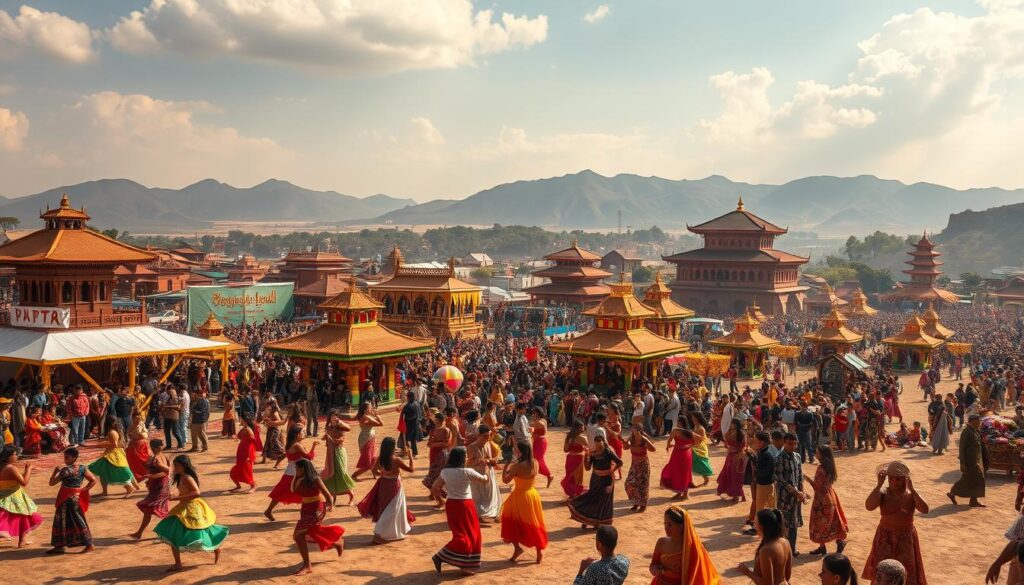
From the northern plains to the southern coasts, local traditions shape how communities commemorate this victory. Each place develops its own distinctive way of honoring the epic story while preserving the core spiritual message.
Comparing Northern and Southern Celebrations
In northern India, elaborate Rama-Lila performances dominate the festivities. Professional and amateur actors recreate scenes from the ancient texts over multiple evenings.
Southern celebrations often integrate the observance into broader Navaratri rituals. This gives the festival a different structural place within the religious calendar.
The name itself varies across regions—known as Dussehra in the north and Vijayadashami in southern areas. Each linguistic community uses local terms for the celebration.
In Mysore, grand processions feature illuminated palaces reflecting royal traditions. Coastal and tribal regions incorporate indigenous elements into their observances.
People in eastern states emphasize Durga Puja aspects during this time. The victory is acknowledged within the context of divine feminine power.
Each regional form maintains spiritual authenticity while expressing local identity. The fundamental message remains constant across all interpretations.
Mythological Characters Beyond the Central Conflict
Beyond the central figures of the epic narrative, a rich cast of supporting characters adds depth and meaning to the story. These individuals each played crucial roles that made the ultimate victory possible.
Their contributions demonstrate how great achievements require collective effort. Each character embodies specific virtues and spiritual lessons.
The Roles of Hanuman, Lakshman, and Sita
Lord Ram‘s immediate companions formed his core support system. His brother Lakshman exemplified unwavering loyalty by joining the forest exile.
He served as protector and constant companion throughout the ordeal. Sita, Lord Ram‘s wife, demonstrated perfect devotion despite her abduction.
Her purity remained intact, becoming the catalyst for evil’s destruction. Hanuman emerged as the embodiment of selfless service and incredible strength.
His role in locating Sita and encouraging the warriors proved pivotal to success.
Supporting Figures and Their Symbolism
Many other characters contributed essential support to the mission. Sugriva, the ape king, mobilized his army of soldiers after Lord Ram helped restore his kingdom.
Matali skillfully drove the divine chariot during the climactic battle. His expertise represented the importance of skilled assistance.
The ocean itself became a character when it appeared in human form. This symbolized how nature cooperates with divine purpose.
Vibhishan chose righteousness over family loyalty, teaching important moral lessons. These supporting figures show that everyone has a role in upholding dharma.
Lessons on Good Over Evil from the Epic Battle
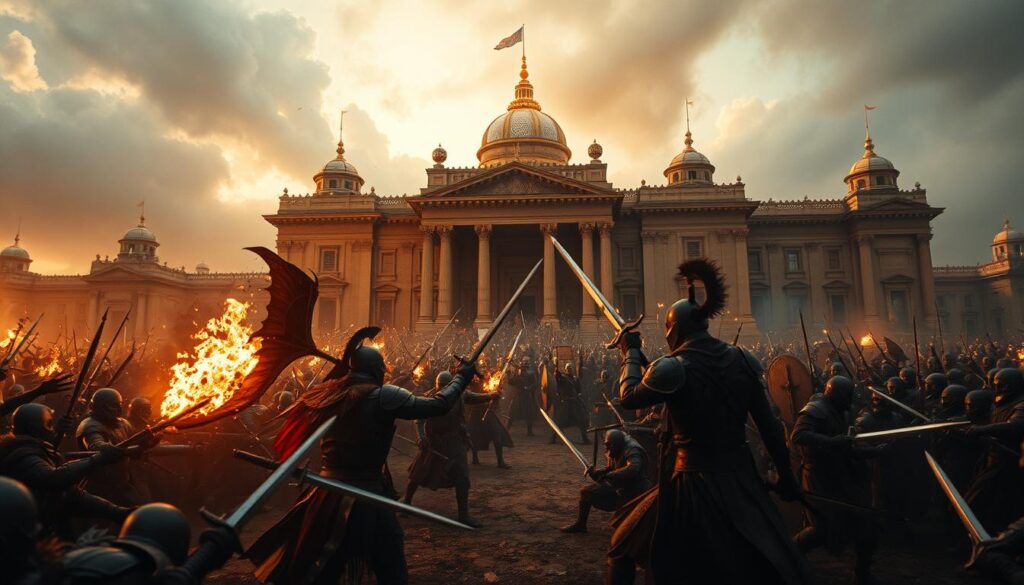
The legendary confrontation between Lord Ram and Ravana offers profound insights into the eternal struggle between righteousness and wickedness. This ancient war provides timeless wisdom about how good ultimately triumphs over evil.
Philosophical Insights and Moral Foundations
Lord Ram‘s conduct throughout the conflict demonstrates adherence to dharma even when facing overwhelming challenges. He fought fiercely but always maintained honor and respect for worthy opponents.
The repeated severing of Ravana’s heads with divine arrows symbolizes ego’s persistent nature. Superficial victories over negative tendencies prove temporary unless addressing root causes.
True strength combines physical prowess with moral clarity. Lord Ram showed that strategic intelligence must guide decisive action. His approach to war exemplifies righteous engagement.
The chariot driven by Matali represents the body and senses requiring expert control. Lord Ram symbolizes the discriminating intelligence governing all actions toward righteous goals.
Evil contains seeds of its own destruction through arrogance and adharma. Despite immense learning and power, the demon king fell due to uncontrolled lust and pride.
The battlefield extends beyond external conflicts to internal struggles. Within each person, principles represented by Lord Ram must triumph over Ravana-like tendencies.
This ultimate victory teaches that cosmic justice bends toward dharma’s restoration. Evil may appear triumphant temporarily but cannot withstand righteous power.
Ramacandra Vijayotsava: Bridging History and Modernity
The ancient victory celebration continues to bridge thousands of years, connecting past and present. This festival demonstrates how timeless spiritual narratives remain relevant across vastly different social contexts.
Connecting Ancient Narratives with Contemporary Values
In today’s time, ethical ambiguity often clouds decision-making. The example of accepting exile to honor a vow provides clear guidance about prioritizing principles.
Contemporary interpretations explore how mythological elements represent modern vices. These include consumerism and corruption that need conquering.
Each person today faces their own challenges requiring courage and persistence. The ancient story becomes personally applicable to modern lives.
The Festival’s Influence on Modern Celebrations
The way contemporary people engage shows ancient wisdom adapting to modern sensibilities. Celebrations incorporate technology while maintaining core messages.
The festival influences modern events far beyond its original context. Themes of good triumphing appear in films and literature worldwide.
For many in the diaspora, celebrations become a way to maintain cultural roots. They build community in new geographical contexts while honoring tradition.
Interpreting the Dual Nature of Evil in Mythology
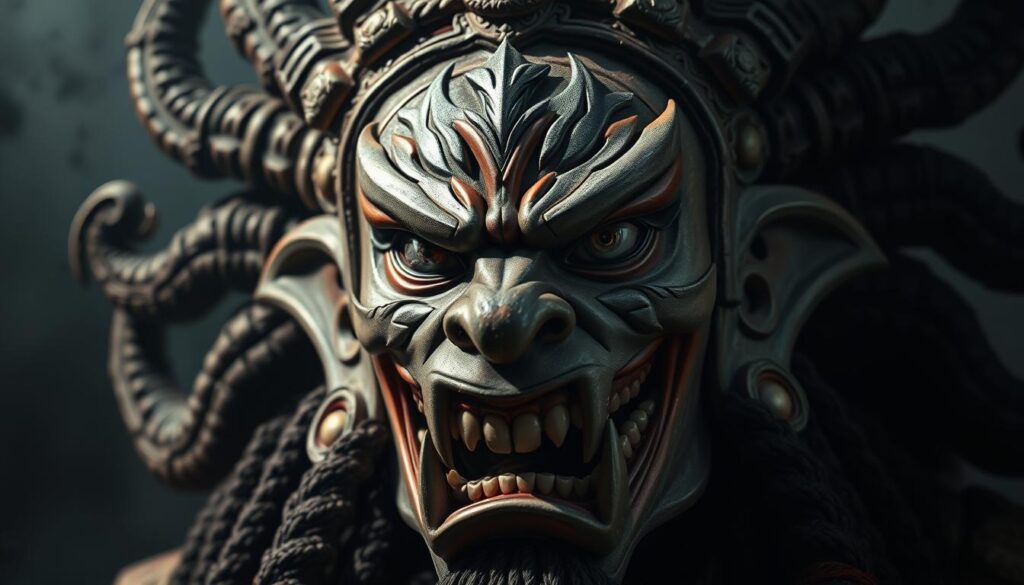
Mythology often presents evil as a complex force with surprising depth. Ravana’s character exemplifies this dual nature, combining extraordinary learning with devastating moral flaws. This challenges simplistic categorizations of good versus evil.
His ten heads carry multiple layers of symbolism. They represent both vast knowledge and the inability to integrate learning with ethical behavior. Each head symbolized different aspects of his fragmented consciousness.
The miraculous regeneration of each ravan head illustrates evil’s persistent quality. When another one immediately replaced each severed head, it showed how vice regenerates endlessly. This occurred on the epic battlefield until one hundred heads lay defeated.
In human form, demons like Ravana appear civilized and accomplished. This teaches that evil rarely announces itself obviously. The name “Dashanana” (ten-headed) emphasizes how unchecked vices define identity.
These mythological demons possess both power and knowledge yet lack wisdom. Their dual nature provides insight into how societies can be simultaneously advanced and destructive. The form evil takes often masks its true nature.
Vijayotsava and the Preservation of Cultural Heritage
The festival serves as a powerful vehicle for cultural preservation. It keeps ancient artistic traditions alive through annual celebrations. These events become living museums of heritage.
Arts, Music, and Drama in the Commemoration
Elaborate Rama-Lila performances represent centuries-old theatrical traditions. They combine music, dance, and dialogue in spectacular shows. These dramas make ancient stories accessible to modern audiences.
Traditional music forms specific to the narrative are preserved through annual performances. Bhajans and classical compositions echo through celebration spaces. Artists maintain skills in costume design and effigy construction specifically for these events.
Traditional Puja and Community Gatherings
Community gatherings create space for intergenerational knowledge sharing. Elders explain significance to youth during this special time. All participate with hands joined in shared cultural experience.
The place where people gather becomes temporarily transformed into sacred space. Traditional puja practices are carefully preserved and taught to new generations. People approach with folded hands in collective worship.
These celebrations anchor distinctive regional identities against globalization. They build social capital through community involvement in organization. The festival ensures cultural continuity for future generations.
Reflections on a Timeless Victory
The enduring legacy of Lord Ram‘s triumph transcends mere historical remembrance. This ancient victory represents an eternal principle that continues to guide people‘s lives across generations.
Each year, the celebration of this sacred day renews commitment to righteousness. The story demonstrates how individual actions influence cosmic balance. Lord Ram‘s descent to earth shows divine intervention in human affairs.
Through thousands of years, the festival’s wisdom remains relevant. It offers hope that good ultimately prevails over darkness. The principles embodied by Lord Ram provide a timeless model for ethical living in any time.
This victory celebration continues to inspire personal transformation. It assures that adherence to dharma leads to ultimate triumph. The Ramacandra Vijayotsava remains a powerful touchstone for spiritual growth.

